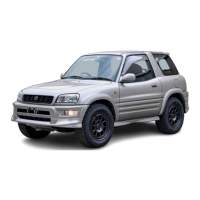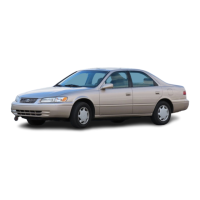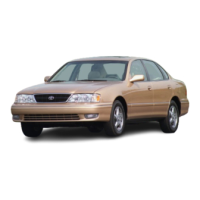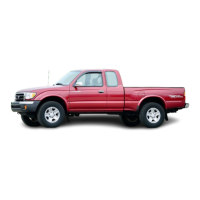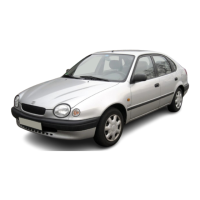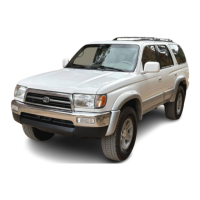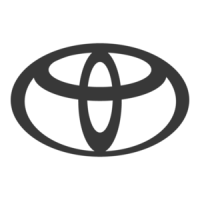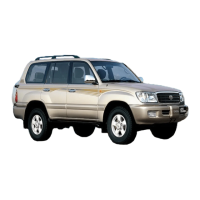Do you have a question about the Toyota 1998 Sienna and is the answer not in the manual?
Provides a general overview of the vehicle's instruments and controls.
Detailed explanation of the layout and components of the instrument panel.
Description of the gauges, meters, and indicators in the instrument cluster.
Explains the meaning and function of various warning and indicator lights.
Information on vehicle keys, door locks, and opening mechanisms.
Details about the master key, subkey, and key number plate.
Instructions for locking and unlocking front doors using keys and interior knobs.
Procedures for operating sliding doors, including locking, unlocking, and closing from outside.
How to use the remote control system for locking, unlocking, and activating the theft deterrent system.
Operation of power windows, including normal and automatic modes.
Operation of the power rear quarter windows.
Operation of manual rear quarter and center side windows.
Instructions for locking and unlocking the back door using the key.
Procedures for opening and closing the vehicle hood.
Explanation of the vehicle's anti-theft system and its operation.
Instructions on how to open and close the fuel tank cap and related cautions.
Operation of the electric moon roof, including sliding and tilting functions.
Information on vehicle seating, proper posture, and seat belt usage.
Important safety precautions to follow when adjusting front seats while driving.
Step-by-step guide for manually adjusting front seats.
Instructions for adjusting front seats using power controls.
Safety guidelines and precautions for rear seat occupants and adjustments.
How to adjust the second-row bench seat, including seatback angle.
Instructions for adjusting second-row captain seats.
Procedure for moving the right-side captain seat to access the third row.
How to fold the second-row bench seat for increased cargo space.
Instructions on how to fold the second-row captain seats.
Steps for removing the second-row bench seat from the vehicle.
Procedure for removing second-row captain seats.
How to adjust the third-row seats for comfort and access.
Instructions on how to fold the third-row seats for cargo space.
Steps for removing the third-row seats from the vehicle.
Proper adjustment and use of head restraints for safety.
How to use the vehicle's armrests.
Essential information and warnings regarding the correct use of seat belts for all occupants.
Details on fastening, adjusting, and maintaining front and rear seat belts.
How to adjust the shoulder anchor for optimal seat belt fit and safety.
Specifics about the right-side seat belt for the second-row bench seat.
Explanation of the two buckles and tabs for the second-row right seat belt.
Instructions for using the rear center seat belt.
Information on obtaining and using seat belt extenders for increased length.
How the front seat belt pretensioner system works and its safety features.
Explanation of the Supplemental Restraint System (SRS) airbags for front occupants.
Crucial safety guidelines for using child restraint systems and general child safety in vehicles.
How to properly install child restraint systems using vehicle seat belts.
Classification of child restraint systems based on child's age and size.
Method for installing child restraints using a 2-point seat belt.
Method for installing child restraints using a 3-point seat belt.
Information on the location and installation of top strap anchors for child restraints.
How to adjust the steering wheel angle for driver comfort and control.
Guide to adjusting outside mirrors for optimal visibility of the vehicle's sides.
How to use the power controls to adjust the rear view mirrors.
Instructions on how to fold the rear view mirrors for parking.
How to adjust the inside rear view mirror to reduce glare.
How to use and adjust the sun visors to block glare.
Operation of vanity mirrors and their associated lights.
Covers operation of vehicle lights, wipers, washers, and defogger systems.
How to operate headlights and turn signals with an automatic light control system.
Instructions for using high and low beam headlights, and flashing high beams.
Operation of headlights and turn signals without automatic light control.
How to use turn signals for normal turns and lane changes.
Operation of the emergency flasher system for hazard warnings.
How to adjust the brightness of the instrument panel lights.
Operation of front and rear personal lights.
Operation of front, center, and rear interior lights.
Information about the ignition switch light and its operation.
How to turn the luggage compartment light on and off.
Operation of windshield wipers and washer fluid squirts.
How to operate the rear window wiper and washer.
Operation of the rear window and outside mirror defogger systems.
Explains the vehicle's gauges, meters, and service reminder indicators.
How the fuel gauge works, its indications, and the low fuel warning light.
How the engine coolant temperature gauge indicates overheating and precautions.
Explanation of the tachometer's function and importance for engine speed.
How to read and reset the odometer and trip meters.
A comprehensive guide to understanding and responding to various warning lights and buzzers.
Details on the ignition switch, steering lock, transmission operation, and parking brake.
How to use the ignition switch, its positions, and the steering lock mechanism.
Explanation of automatic transmission operation, shift positions, and overdrive control.
How to set and release the parking brake and related warnings.
How to use the cruise control system for maintaining speed and its operating conditions.
Covers the vehicle's audio system and air conditioning controls.
General reference to the car audio system's components and features.
Basic introduction to the Toyota audio system's functions and operation.
Detailed explanation of the specific buttons, controls, and features of the audio system.
Overview of the controls for the vehicle's air conditioning system.
How to adjust the fan speed for the air conditioning system.
How to adjust the temperature settings of the air conditioning.
How to select different air flow modes for heating, cooling, and ventilation.
How to choose between recirculated and fresh air intake for the climate control.
Operation of the air conditioning compressor button and its indicator light.
Diagrams showing air flow selector settings for different models.
Practical advice for optimizing the use of the air conditioning system.
Recommended control settings for effective heating of the vehicle interior.
Recommended settings for efficient cooling of the vehicle interior.
Recommended settings for fresh air ventilation.
Recommended settings for clearing fog from the windshield.
Recommended control settings for defrosting the windshield.
Information on the operation and adjustment of instrument panel vents.
Controls for the rear air conditioning system in 4-door models.
Diagrams showing air flow selector settings for 4-door and 5-door models.
How to open and close the roof vents for air flow.
Covers various other vehicle equipment and accessories.
How to set and reset the digital clock.
Operation of the cigarette lighter and use of the ashtray.
How to use and remove the vehicle's ashtray.
Information on using power outlets for accessories and their limitations.
How to open and lock the glovebox.
Instructions for storing a garage door opener transmitter in the vehicle.
Explanation of how to use different types of auxiliary storage boxes.
How to use the vehicle's cup holder for beverages.
Location and use of the auxiliary box for storing safety equipment.
How the tire pressure warning system works and its indications.
Explanation of the tire pressure warning light and how to respond to it.
How to properly use and secure floor mats to prevent accidents.
Recommended procedures for breaking in a new vehicle to ensure longevity.
Specifications and recommendations for the type of gasoline to use in the vehicle.
Advice for driving a Toyota in foreign countries.
Explanation of the catalytic converter's function and safety precautions.
Important safety warnings regarding engine exhaust and its hazards.
Explains normal engine oil consumption and factors influencing it.
Emphasizes the critical importance of regular engine oil level checks.
Information about the specific type of spark plugs used in the vehicle.
Overview of the vehicle's tandem master cylinder brake system.
How the brake booster uses engine vacuum to assist braking.
Explanation of the ABS system's function, operation, and driving advice.
What the ABS warning light indicates and when to seek service.
How brake pad wear indicators alert the driver to replacement needs.
Guidelines for safely stowing luggage and cargo in the vehicle.
How to adjust and use the roof luggage carrier system.
Location and importance of the Vehicle Identification Number (VIN).
Location of the engine number stamped on the engine block.
Information about theft prevention labels and their purpose.
Warnings about modifying the suspension or chassis.
Description and recommendations for summer, all-season, and snow tires.
Essential checks to perform before starting the engine.
Step-by-step instructions for the initial actions before cranking the engine.
Normal starting procedures for cold and hot engines, and what to do if the engine stalls.
Advice for driving safely in different conditions like crosswinds, curbs, and wet roads.
Recommendations for preparing and driving the vehicle in winter conditions.
Guidelines and precautions for towing a trailer with the vehicle.
Critical information on vehicle and trailer weight limits to ensure safety and prevent damage.
Advice on selecting and installing trailer hitches.
Recommendations for trailer brakes and safety chains for secure towing.
Proper tire inflation and checks for tire condition.
Compliance of trailer lights with regulations and checking their operation.
Recommended break-in procedures when towing a trailer.
How towing affects vehicle maintenance schedules.
Essential safety checks before towing a trailer.
Crucial advice for safe trailer towing, including handling, speed, and braking.
Tips for improving fuel economy and extending vehicle life through proper driving habits.
Steps for diagnosing and resolving issues when the vehicle won't start.
Procedure for starting an engine that may be flooded with fuel.
Detailed instructions and safety precautions for jump-starting a vehicle's battery.
What to do if the engine stalls while the vehicle is in motion.
Steps to take if the vehicle's engine overheats, including safety warnings.
Instructions for safely changing a flat tire, including jacking and wheel removal.
Information and limitations regarding the use of the compact spare tire.
List of essential tools and the spare tire, and their storage locations.
How to block the wheel to prevent the vehicle from rolling when jacked up.
How to remove steel and aluminum wheel ornaments.
Steps for loosening wheel nuts before lifting the vehicle.
How to correctly position the jack at the designated points.
Instructions on how to safely raise the vehicle using the jack.
Steps for removing the flat tire and installing the spare.
How to reinstall and tighten wheel nuts after changing a tire.
Procedure for safely lowering the vehicle after changing a wheel.
How to reinstall wheel ornaments on steel and aluminum wheels.
Post-tire change checks, including air pressure and wheel nut tightening.
Different methods and precautions for towing the vehicle.
Procedures and notices for towing with a wheel lift truck.
Guidelines for towing the vehicle on a flat bed truck.
Warnings against using sling type trucks for towing.
Instructions for emergency towing using towing eyelets, with critical safety advice.
What to do if you lose your vehicle keys, including getting replacements.
Steps to take if you lose the wireless remote transmitter and how to get a new one.
Common causes of corrosion and essential steps to prevent it.
How to properly wash and wax the vehicle to maintain its finish and prevent corrosion.
Detailed instructions for cleaning the vehicle's interior surfaces like vinyl, carpets, and windows.
Explanation of the importance of maintenance for vehicle longevity and performance.
Day-to-day care practices essential for proper vehicle operation.
Guidance on choosing between DIY maintenance and professional service at a Toyota dealer.
Specific general maintenance items to check regularly.
Regular checks for fluids and components within the engine compartment.
Clues and symptoms that indicate the vehicle may need professional service or repair.
Introduction to the do-it-yourself maintenance section, covering engine overview and tools.
A diagram and list of major components located in the engine compartment.
Diagrams showing the location of fuse boxes in the engine compartment and instrument panel.
Critical safety precautions and warnings to observe when performing DIY maintenance.
A list of necessary parts and tools for common do-it-yourself maintenance tasks.
Covers checks and maintenance related to the vehicle's engine and chassis components.
Step-by-step instructions for checking and adding engine oil correctly.
Guidance on selecting the correct API and SAE grades for engine oil.
How to check the engine coolant level and add coolant if necessary.
Recommendations for the correct type of coolant to use and antifreeze protection.
How to check the brake fluid level and add fluid if needed.
How to check the power steering fluid level and add fluid if necessary.
Instructions on how to check tire pressure accurately and the importance of proper inflation.
How to check tire tread for wear indicators and guidelines for replacing tires.
Why and how to rotate tires to equalize wear and extend tire life.
Recommendations for using snow tires and installing tire chains.
Guidance on selecting the correct size and type of tire chains.
What to consider when replacing vehicle wheels, including size and load capacity.
Specific precautions related to the maintenance and use of aluminum wheels.
Covers checks and maintenance of the vehicle's electrical system components.
Essential safety precautions and emergency measures when checking the vehicle battery.
How to inspect the battery for corrosion, loose connections, and damage.
Using a hydrometer to check the battery's electrolyte condition.
Safety guidelines and precautions to follow when recharging the vehicle battery.
How to check for blown fuses and replace them with the correct type.
Instructions for adding washer fluid and precautions regarding fluid types.
Step-by-step guide and bulb type information for replacing various exterior and interior lights.
How to access and replace headlight bulbs.
How to replace bulbs for parking, turn signal, and side marker lights.
Procedures for replacing bulbs in the rear turn signal, stop, and tail light assemblies.
How to replace bulbs for stop, tail, and back-up lights.
How to replace license plate light bulbs.
How to access and replace the high-mounted stoplight bulb.
Vehicle dimensions, weight ratings, and related specifications.
Specifications related to the vehicle's engine, including model, type, bore, stroke, and displacement.
Fuel type recommendations and fuel tank capacity.
Key service specifications like valve clearance, spark plug type/gap, and drive belt tension.
Engine oil capacity, grade recommendations, and viscosity charts.
Cooling system capacity and coolant type selection.
Differential fluid capacity and type.
Brake system specifications, including pedal clearance and wear limits.
Specifications for the automatic transmission fluid capacity and type.
Specifications for steering wheel freeplay and power steering fluid type.
Tire sizes, pressures for normal driving and trailer towing, and wheel nut torque.
Diagrams showing fuse box layouts and identification of fuses by type and circuit.
How to report safety defects to the National Highway Traffic Safety Administration (NHTSA).
Explanation of tire quality grading factors: Treadwear, Traction, and Temperature.
Explains the meaning of CAUTION, NOTICE, and safety symbols used in the manual.
Provides a general overview of the vehicle's instruments and controls.
Detailed explanation of the layout and components of the instrument panel.
Description of the gauges, meters, and indicators in the instrument cluster.
Explains the meaning and function of various warning and indicator lights.
Information on vehicle keys, door locks, and opening mechanisms.
Details about the master key, subkey, and key number plate.
Instructions for locking and unlocking front doors using keys and interior knobs.
Procedures for operating sliding doors, including locking, unlocking, and closing from outside.
How to use the remote control system for locking, unlocking, and activating the theft deterrent system.
Operation of power windows, including normal and automatic modes.
Operation of the power rear quarter windows.
Operation of manual rear quarter and center side windows.
Instructions for locking and unlocking the back door using the key.
Procedures for opening and closing the vehicle hood.
Explanation of the vehicle's anti-theft system and its operation.
Instructions on how to open and close the fuel tank cap and related cautions.
Operation of the electric moon roof, including sliding and tilting functions.
Information on vehicle seating, proper posture, and seat belt usage.
Important safety precautions to follow when adjusting front seats while driving.
Step-by-step guide for manually adjusting front seats.
Instructions for adjusting front seats using power controls.
Safety guidelines and precautions for rear seat occupants and adjustments.
How to adjust the second-row bench seat, including seatback angle.
Instructions for adjusting second-row captain seats.
Procedure for moving the right-side captain seat to access the third row.
How to fold the second-row bench seat for increased cargo space.
Instructions on how to fold the second-row captain seats.
Steps for removing the second-row bench seat from the vehicle.
Procedure for removing second-row captain seats.
How to adjust the third-row seats for comfort and access.
Instructions on how to fold the third-row seats for cargo space.
Steps for removing the third-row seats from the vehicle.
Proper adjustment and use of head restraints for safety.
How to use the vehicle's armrests.
Essential information and warnings regarding the correct use of seat belts for all occupants.
Details on fastening, adjusting, and maintaining front and rear seat belts.
How to adjust the shoulder anchor for optimal seat belt fit and safety.
Specifics about the right-side seat belt for the second-row bench seat.
Explanation of the two buckles and tabs for the second-row right seat belt.
Instructions for using the rear center seat belt.
Information on obtaining and using seat belt extenders for increased length.
How the front seat belt pretensioner system works and its safety features.
Explanation of the Supplemental Restraint System (SRS) airbags for front occupants.
Crucial safety guidelines for using child restraint systems and general child safety in vehicles.
How to properly install child restraint systems using vehicle seat belts.
Classification of child restraint systems based on child's age and size.
Method for installing child restraints using a 2-point seat belt.
Method for installing child restraints using a 3-point seat belt.
Information on the location and installation of top strap anchors for child restraints.
How to adjust the steering wheel angle for driver comfort and control.
Guide to adjusting outside mirrors for optimal visibility of the vehicle's sides.
How to use the power controls to adjust the rear view mirrors.
Instructions on how to fold the rear view mirrors for parking.
How to adjust the inside rear view mirror to reduce glare.
How to use and adjust the sun visors to block glare.
Operation of vanity mirrors and their associated lights.
Covers operation of vehicle lights, wipers, washers, and defogger systems.
How to operate headlights and turn signals with an automatic light control system.
Instructions for using high and low beam headlights, and flashing high beams.
Operation of headlights and turn signals without automatic light control.
How to use turn signals for normal turns and lane changes.
Operation of the emergency flasher system for hazard warnings.
How to adjust the brightness of the instrument panel lights.
Operation of front and rear personal lights.
Operation of front, center, and rear interior lights.
Information about the ignition switch light and its operation.
How to turn the luggage compartment light on and off.
Operation of windshield wipers and washer fluid squirts.
How to operate the rear window wiper and washer.
Operation of the rear window and outside mirror defogger systems.
Explains the vehicle's gauges, meters, and service reminder indicators.
How the fuel gauge works, its indications, and the low fuel warning light.
How the engine coolant temperature gauge indicates overheating and precautions.
Explanation of the tachometer's function and importance for engine speed.
How to read and reset the odometer and trip meters.
A comprehensive guide to understanding and responding to various warning lights and buzzers.
Details on the ignition switch, steering lock, transmission operation, and parking brake.
How to use the ignition switch, its positions, and the steering lock mechanism.
Explanation of automatic transmission operation, shift positions, and overdrive control.
How to set and release the parking brake and related warnings.
How to use the cruise control system for maintaining speed and its operating conditions.
Covers the vehicle's audio system and air conditioning controls.
General reference to the car audio system's components and features.
Basic introduction to the Toyota audio system's functions and operation.
Detailed explanation of the specific buttons, controls, and features of the audio system.
Overview of the controls for the vehicle's air conditioning system.
How to adjust the fan speed for the air conditioning system.
How to adjust the temperature settings of the air conditioning.
How to select different air flow modes for heating, cooling, and ventilation.
How to choose between recirculated and fresh air intake for the climate control.
Operation of the air conditioning compressor button and its indicator light.
Diagrams showing air flow selector settings for different models.
Practical advice for optimizing the use of the air conditioning system.
Recommended control settings for effective heating of the vehicle interior.
Recommended settings for efficient cooling of the vehicle interior.
Recommended settings for fresh air ventilation.
Recommended settings for clearing fog from the windshield.
Recommended control settings for defrosting the windshield.
Information on the operation and adjustment of instrument panel vents.
Controls for the rear air conditioning system in 4-door models.
Diagrams showing air flow selector settings for 4-door and 5-door models.
How to open and close the roof vents for air flow.
Covers various other vehicle equipment and accessories.
How to set and reset the digital clock.
Operation of the cigarette lighter and use of the ashtray.
How to use and remove the vehicle's ashtray.
Information on using power outlets for accessories and their limitations.
How to open and lock the glovebox.
Instructions for storing a garage door opener transmitter in the vehicle.
Explanation of how to use different types of auxiliary storage boxes.
How to use the vehicle's cup holder for beverages.
Location and use of the auxiliary box for storing safety equipment.
How the tire pressure warning system works and its indications.
Explanation of the tire pressure warning light and how to respond to it.
How to properly use and secure floor mats to prevent accidents.
Recommended procedures for breaking in a new vehicle to ensure longevity.
Specifications and recommendations for the type of gasoline to use in the vehicle.
Advice for driving a Toyota in foreign countries.
Explanation of the catalytic converter's function and safety precautions.
Important safety warnings regarding engine exhaust and its hazards.
Explains normal engine oil consumption and factors influencing it.
Emphasizes the critical importance of regular engine oil level checks.
Information about the specific type of spark plugs used in the vehicle.
Overview of the vehicle's tandem master cylinder brake system.
How the brake booster uses engine vacuum to assist braking.
Explanation of the ABS system's function, operation, and driving advice.
What the ABS warning light indicates and when to seek service.
How brake pad wear indicators alert the driver to replacement needs.
Guidelines for safely stowing luggage and cargo in the vehicle.
How to adjust and use the roof luggage carrier system.
Location and importance of the Vehicle Identification Number (VIN).
Location of the engine number stamped on the engine block.
Information about theft prevention labels and their purpose.
Warnings about modifying the suspension or chassis.
Description and recommendations for summer, all-season, and snow tires.
Essential checks to perform before starting the engine.
Step-by-step instructions for the initial actions before cranking the engine.
Normal starting procedures for cold and hot engines, and what to do if the engine stalls.
Advice for driving safely in different conditions like crosswinds, curbs, and wet roads.
Recommendations for preparing and driving the vehicle in winter conditions.
Guidelines and precautions for towing a trailer with the vehicle.
Critical information on vehicle and trailer weight limits to ensure safety and prevent damage.
Advice on selecting and installing trailer hitches.
Recommendations for trailer brakes and safety chains for secure towing.
Proper tire inflation and checks for tire condition.
Compliance of trailer lights with regulations and checking their operation.
Recommended break-in procedures when towing a trailer.
How towing affects vehicle maintenance schedules.
Essential safety checks before towing a trailer.
Crucial advice for safe trailer towing, including handling, speed, and braking.
Tips for improving fuel economy and extending vehicle life through proper driving habits.
Steps for diagnosing and resolving issues when the vehicle won't start.
Procedure for starting an engine that may be flooded with fuel.
Detailed instructions and safety precautions for jump-starting a vehicle's battery.
What to do if the engine stalls while the vehicle is in motion.
Steps to take if the vehicle's engine overheats, including safety warnings.
Instructions for safely changing a flat tire, including jacking and wheel removal.
Information and limitations regarding the use of the compact spare tire.
List of essential tools and the spare tire, and their storage locations.
How to block the wheel to prevent the vehicle from rolling when jacked up.
How to remove steel and aluminum wheel ornaments.
Steps for loosening wheel nuts before lifting the vehicle.
How to correctly position the jack at the designated points.
Instructions on how to safely raise the vehicle using the jack.
Steps for removing the flat tire and installing the spare.
How to reinstall and tighten wheel nuts after changing a tire.
Procedure for safely lowering the vehicle after changing a wheel.
How to reinstall wheel ornaments on steel and aluminum wheels.
Post-tire change checks, including air pressure and wheel nut tightening.
Different methods and precautions for towing the vehicle.
Procedures and notices for towing with a wheel lift truck.
Guidelines for towing the vehicle on a flat bed truck.
Warnings against using sling type trucks for towing.
Instructions for emergency towing using towing eyelets, with critical safety advice.
What to do if you lose your vehicle keys, including getting replacements.
Steps to take if you lose the wireless remote transmitter and how to get a new one.
Common causes of corrosion and essential steps to prevent it.
How to properly wash and wax the vehicle to maintain its finish and prevent corrosion.
Detailed instructions for cleaning the vehicle's interior surfaces like vinyl, carpets, and windows.
Explanation of the importance of maintenance for vehicle longevity and performance.
Day-to-day care practices essential for proper vehicle operation.
Guidance on choosing between DIY maintenance and professional service at a Toyota dealer.
Specific general maintenance items to check regularly.
Regular checks for fluids and components within the engine compartment.
Clues and symptoms that indicate the vehicle may need professional service or repair.
Introduction to the do-it-yourself maintenance section, covering engine overview and tools.
A diagram and list of major components located in the engine compartment.
Diagrams showing the location of fuse boxes in the engine compartment and instrument panel.
Critical safety precautions and warnings to observe when performing DIY maintenance.
A list of necessary parts and tools for common do-it-yourself maintenance tasks.
Covers checks and maintenance related to the vehicle's engine and chassis components.
Step-by-step instructions for checking and adding engine oil correctly.
Guidance on selecting the correct API and SAE grades for engine oil.
How to check the engine coolant level and add coolant if necessary.
Recommendations for the correct type of coolant to use and antifreeze protection.
How to check the brake fluid level and add fluid if needed.
How to check the power steering fluid level and add fluid if necessary.
Instructions on how to check tire pressure accurately and the importance of proper inflation.
How to check tire tread for wear indicators and guidelines for replacing tires.
Why and how to rotate tires to equalize wear and extend tire life.
Recommendations for using snow tires and installing tire chains.
Guidance on selecting the correct size and type of tire chains.
What to consider when replacing vehicle wheels, including size and load capacity.
Specific precautions related to the maintenance and use of aluminum wheels.
Covers checks and maintenance of the vehicle's electrical system components.
Essential safety precautions and emergency measures when checking the vehicle battery.
How to inspect the battery for corrosion, loose connections, and damage.
Using a hydrometer to check the battery's electrolyte condition.
Safety guidelines and precautions to follow when recharging the vehicle battery.
How to check for blown fuses and replace them with the correct type.
Instructions for adding washer fluid and precautions regarding fluid types.
Step-by-step guide and bulb type information for replacing various exterior and interior lights.
How to access and replace headlight bulbs.
How to replace bulbs for parking, turn signal, and side marker lights.
Procedures for replacing bulbs in the rear turn signal, stop, and tail light assemblies.
How to replace bulbs for stop, tail, and back-up lights.
How to replace license plate light bulbs.
How to access and replace the high-mounted stoplight bulb.
Vehicle dimensions, weight ratings, and related specifications.
Specifications related to the vehicle's engine, including model, type, bore, stroke, and displacement.
Fuel type recommendations and fuel tank capacity.
Key service specifications like valve clearance, spark plug type/gap, and drive belt tension.
Engine oil capacity, grade recommendations, and viscosity charts.
Cooling system capacity and coolant type selection.
Differential fluid capacity and type.
Brake system specifications, including pedal clearance and wear limits.
Specifications for the automatic transmission fluid capacity and type.
Specifications for steering wheel freeplay and power steering fluid type.
Tire sizes, pressures for normal driving and trailer towing, and wheel nut torque.
Diagrams showing fuse box layouts and identification of fuses by type and circuit.
How to report safety defects to the National Highway Traffic Safety Administration (NHTSA).
Explanation of tire quality grading factors: Treadwear, Traction, and Temperature.
Explains the meaning of CAUTION, NOTICE, and safety symbols used in the manual.
| Brand | Toyota |
|---|---|
| Model | 1998 Sienna |
| Category | Automobile |
| Language | English |
